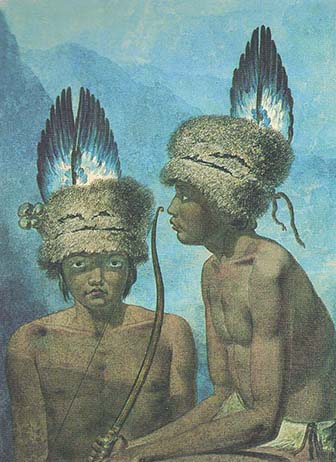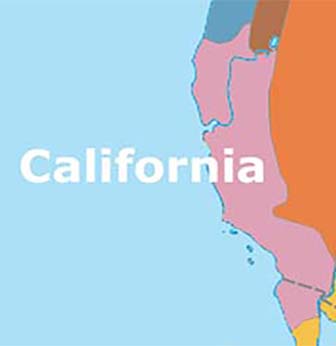California Tribes
Before European contact, native Californians spoke over 300 dialects of approximately 100 distinct languages.

The Indigenous peoples of California (known as Native Californians) are the indigenous inhabitants who have lived or currently live in the geographic area within the current boundaries of California before and after the arrival of Europeans. With over forty groups seeking to be federally recognized tribes, California has the second largest Native American population in the United States. The California cultural area does not conform exactly to the state of California's boundaries. Many tribes on the eastern border with Nevada are classified as Great Basin tribes, and some tribes on the Oregon border are classified as Plateau tribes. Tribes in Baja California who do not cross into California are classified as Indigenous peoples of Mexico.
Evidence of human occupation of California dates from at least 19,000 years ago. Prior to European contact, California Indians had 500 distinct sub-tribes or groups, each consisting of 50 to 500 individual members. The size of California tribes today are small compared to tribes in other regions of the United States. Prior to contact with Europeans, the California region contained the highest Native American population density north of what is now Mexico. Because of the temperate climate and easy access to food sources, approximately one-third of all Native Americans in the United States were living in the area of California.
Early Native Californians were hunter-gatherers, with seed collection becoming widespread around 9,000 BC. Due to the local abundance of food, tribes never developed agriculture or tilled the soil. Two early southern California cultural traditions include the La Jolla Complex and the Pauma Complex, both dating from ca. 6050—1000 BC.
The indigenous people practiced various forms of sophisticated forest gardening in the forests, grasslands, mixed woodlands, and wetlands to ensure availability of food and medicine plants. They controlled fire on a regional scale to create a low-intensity fire ecology; this prevented larger, catastrophic fires and sustained a low-density "wild" agriculture in loose rotation. By burning underbrush and grass, the natives revitalized patches of land and provided fresh shoots to attract food animals. A form of fire-stick farming was used to clear areas of old growth to encourage new in a repeated cycle; a permaculture.

California Tribes
- Achomawi
- Antoniaño
- Atsugewi
- Bear River Tribe
- Cahuilla
- Campo
- Chemehuevi
- Chukchansi
- Chumash
- Chilula
- Chimariko
- Coast Miwok
- Costanoan, or Ohlone
- Cupeño
- Diegueño, or Kumeyaay
- Esselen
- Fernandeño, or Tataviam
- Gabrieliño, or Tongva
- Hupa
- Ipai, or Kumeyaay
- Jamul
- Juaneño
- Kamia
- Karok
- Kato
- Kiliwa
- Kitanemuk
- Klamath
- Konkow, or Maidu
- Konomihu
- Kumeyaay
- Lake Miwok
- Lassik
- Luiseño
- Maidu
- Mattole
- Mesa Grande
- Migueleño
- Mission Indians
- Miwok
- Modoc
- Mohave
- Monache
- Nakipa
- Nisenan
- Nomlaki
- Nongatl
- Ohlone
- Okwanuchu
- Paipai
- Paiute
- Patwin
- Pit River, or Achomawi
- Pomo
- Rumsen, or Ohlone
- Salinan
- San Clemente
- San Nicolas
- Santa Catalina
- Serrano
- Shasta
- Sierra Miwok
- Sinkyone
- Suisunes
- Tache
- Tachi tribe
- Tataviam
- Tipai, or Kumeyaay
- Tolowa
- Tongva
- Tsnungwe
- Tubatulabal
- Wai-lakki
- Wappo
- Washoe
- Whilkut
- Wintu
- Wintun
- Wiyot
- Valley Miwok
- Yahi
- Yelamu
- Yana
- Yocha Dehe
- Yokuts
- Yuki
- Yurok
Return to the: North American Tribal Regions Map
Missions Era
The Spanish began their long-term occupation in California in 1769 with the founding of Mission San Diego de Alcalá in San Diego. The Spanish built 20 additional missions in California. Their introduction of European invasive plant species and non-native diseases resulted in unintended havoc and high fatalities for the Native populations.
In 1834 Mexico secularized the Church's missions and confiscated their properties. But the new government did not return their lands to tribes but made land grants to settlers of at least partial European ancestry. Many landless Indians found wage labor on ranches. Following the United States victory in the Mexican-American War, it took control of California in 1848 with the signing of the Treaty of Guadalupe Hidalgo. Its administrators worked to honor Mexican land grant title but did not honor aboriginal land title.
The population of Native California was reduced by 90% during the 19th century—from more than 200,000 in the early 19th century to approximately 15,000 at the end of the century, mostly due to disease. Epidemics swept through California Indian Country, such as the 1833 malaria epidemic.
California Tribes Today
California has the largest population of Native Americans out of any state in the United States, with 723,000 identifying an "American Indian or Alaska Native" tribe as a component of their race (14% of the nation-wide total). This population grew by 15% between 2000 and 2010, much less than the nation-wide growth rate of 27%, but higher than the population growth rate for all races, which was about 10% in California over that decade. Over 50,000 indigenous people live in Los Angeles alone. According to the National Conference of State Legislatures, there are currently over one hundred federally recognized native groups or tribes in California including those that spread to several states.
Return to the: North American Tribal Regions Map
